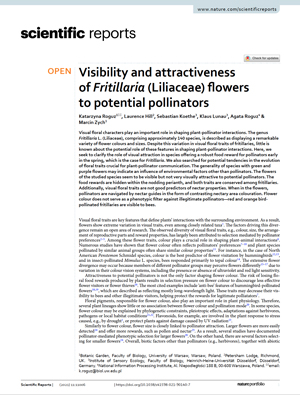NEWS 2021
Visibility and attractiveness of Fritillaria (Liliaceae) flowers to potential pollinators
Katarzyna ROGUZ1, Laurence HILL2, Sebastian KOETHE3, Klaus LUNAU3, Agata ROGUZ4, Marcin ZYCH 1
Scientific Reports 11, Article number: 11006 (2021)
https://doi.org/10.1038/s41598-021-90140-7
1Botanic Garden, Faculty of Biology, University of Warsaw, Warsaw, Poland
2Petersham Lodge, Richmond, United Kingdom
3Institute of Sensory Ecology, Faculty of Biology, Heinrich-Heine-Universität Düsseldorf, Düsseldorf, Germany
4National Information Processing Institute, Al. Niepodległości 188 B, 00‑608 Warszawa, Poland
Abstract
Visual floral characters play an important role in shaping plant-pollinator interactions. The genus Fritillaria L. (Liliaceae), comprising approximately 140 species, is described as displaying a remarkable variety of flower colours and sizes. Despite this variation in visual floral traits of fritillaries, little is known about the potential role of these features in shaping plant-pollinator interactions. Here, we seek to clarify the role of visual attraction in species offering a robust food reward for pollinators early in the spring, which is the case for Fritillaria. We also searched for potential tendencies in the evolution of floral traits crucial for plant-pollinator communication. The generality of species with green and purple flowers may indicate an influence of environmental factors other than pollinators. The flowers of the studied species seem to be visible but not very visually attractive to potential pollinators. The food rewards are hidden within the nodding perianth, and both traits are conserved among fritillaries. Additionally, visual floral traits are not good predictors of nectar properties. When in the flowers, pollinators are navigated by nectar guides in the form of contrasting nectary area colouration. Flower colour does not serve as a phenotypic filter against illegitimate pollinators—red and orange bird-pollinated fritillaries are visible to bees.




